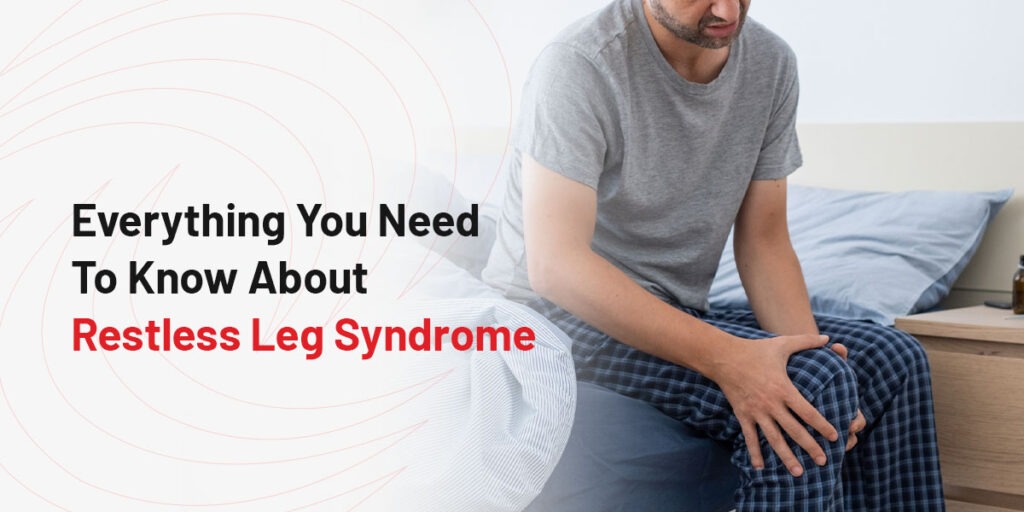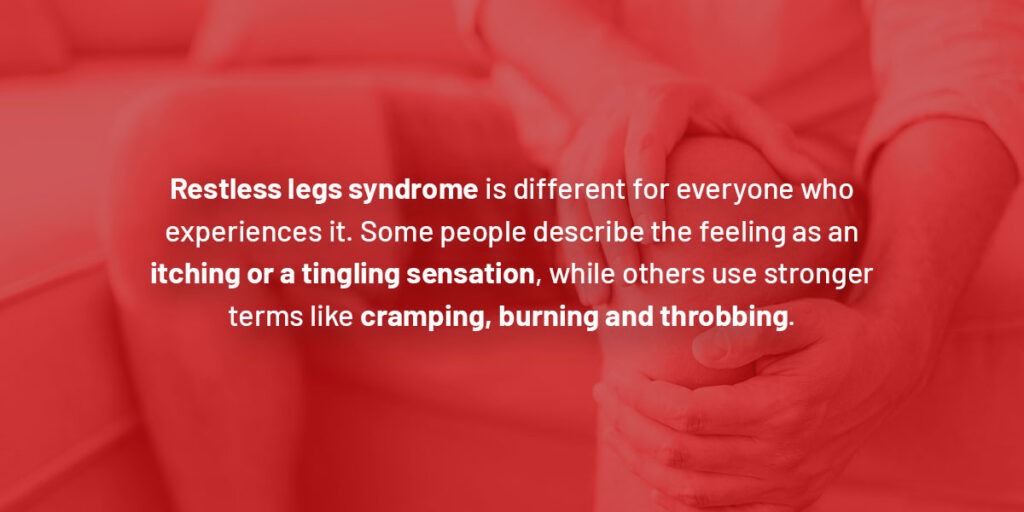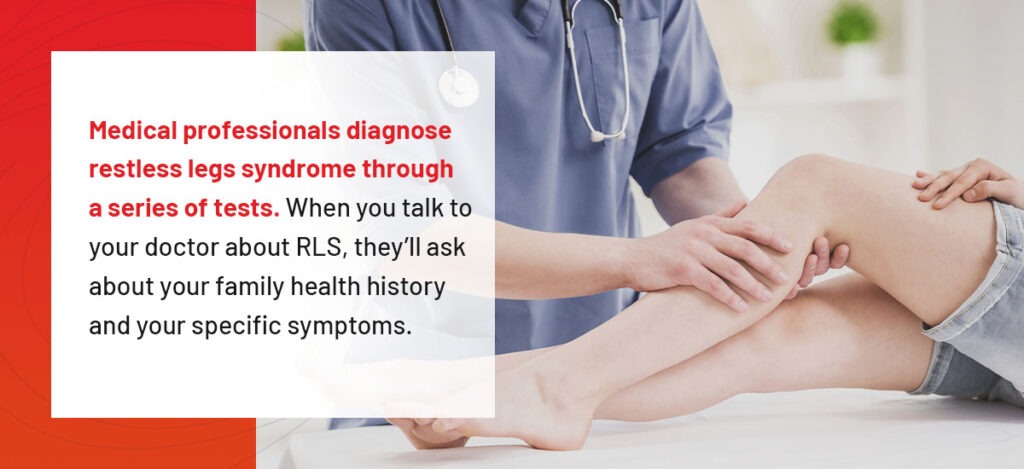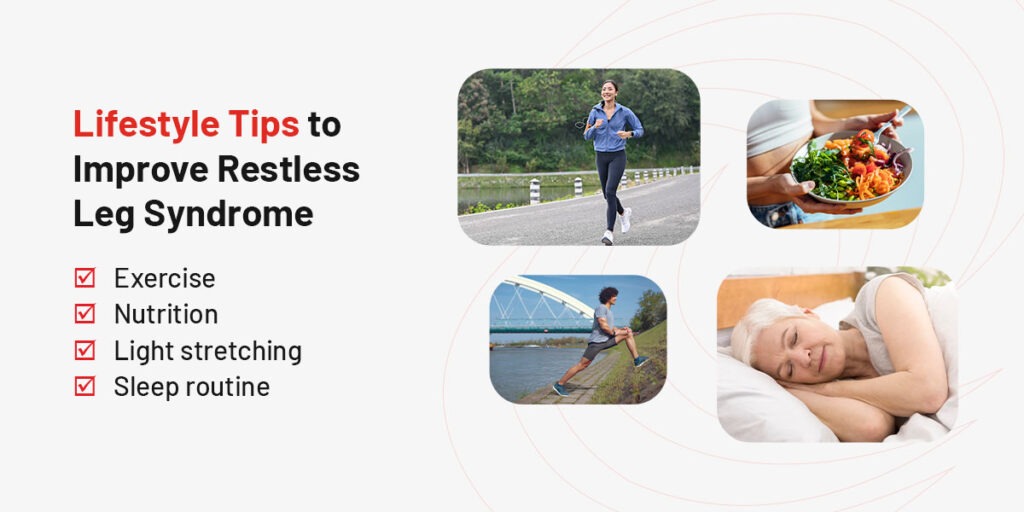
Do you ever have trouble sleeping because your legs and feet feel itchy, tingly or cramped? You may be experiencing restless legs syndrome (RLS), a condition that affects up to 10% of people in the United States. RLS usually happens at night or when a person has to sit still for a long time.
Depending on its severity, RLS can disrupt your sleep patterns, mental health and more. Although there’s no cure for restless legs syndrome, there are many treatment options that can reduce the itchy or painful feeling. Keep reading to learn more about restless legs syndrome — its symptoms, what causes it, and what to do if you experience it.

Restless legs syndrome is different for everyone who experiences it. Some people describe the feeling as an itching or a tingling sensation, while others use stronger terms like cramping, burning and throbbing. Symptoms of restless legs syndrome cover a broad range from mild to severe.
Regardless of the words they use, the feeling makes people want to kick and move their legs, usually when they lay down to sleep. Keeping your legs still when you have this sensation will make the feeling worse, and eventually, you’ll be compelled to move your legs to relieve it.
While some only experience RLS occasionally, others may have trouble sleeping every night because their legs bother them so much. In some cases, the feeling of restlessness can also affect the arms, chest and face — although it most often only affects a person’s legs.
Most people experience RLS in the evening and when they lie down to sleep. However, RLS can also affect people who sit still for a long time. You might notice a mild to severe feeling of restlessness if you travel in a car, plane or train or sit for long hours at work or home.
According to the National Institute for Neurological Disorders and Stroke, over 80% of individuals with RLS also have PLMS, or periodic limb movement of sleep. Individuals with PLMS experience irregular movement — like jerking and cramping — in their lower limbs while they sleep. Whether or not they wake up, PLMS will disrupt their sleep.
Restless legs syndrome can impact anyone regardless of age or gender. However, it’s most often noticed in people who are older — likely because they may have co-occurring conditions. For example, individuals who have neuropathy are more likely to experience RLS. It also seems to be more prevalent in women than in men.
While severe RLS tends to impact older adults, it can occasionally occur in young children, teenagers and young adults as well. Mild restless legs syndrome is sometimes misdiagnosed, but the symptoms are so unique that you should know if you experiencing the condition.

Medical professionals diagnose restless legs syndrome through a series of tests. When you talk to your doctor about RLS, they’ll ask about your family health history and your specific symptoms. Sometimes, restless legs syndrome seems to run in families.
If your symptoms clearly indicate restless legs syndrome, your doctor will probably run further tests to help determine the cause. They may conduct a physical exam, a neurological exam or run bloodwork to help identify any potential underlying conditions. Understanding the cause of RLS will help with your treatment plan.
Medical care professionals are still learning about RLS. It can be caused by several different underlying conditions or can exist on its own. One theory is that RLS could be a result of dopamine disruption in the brain.
If you experience RLS, it’s important to see a doctor so you can determine why it’s happening. While there are many treatment options available, the most effective option for RLS can vary widely depending on the cause. There are two ways restless leg syndrome is diagnosed — either as a primary or a secondary cause.
Most patients are diagnosed with primary RLS, which means that there isn’t a known underlying condition causing restless legs syndrome. If you experience this type of RLS, it may be genetic, related to lifestyle choices or caused by something that’s not yet understood.
Thankfully, there are a number of practical steps you can take to treat primary RLS symptoms. Going to your doctor lets you rule out whether anything else is going on so you can have confidence moving forward with your treatment options.
If you are diagnosed with secondary RLS, you have an underlying condition that’s causing the problem. Doctors will focus on treating your underlying condition to help manage the RLS symptoms. You can also pursue strategies to reduce the discomfort in your legs.
Sometimes, RLS can be a sign of iron deficiency, trouble with your kidneys or even peripheral neuropathy. If you take certain antidepressants or psychiatric medications, these can also cause RLS. Always talk to your doctor before changing these medications, even if they are the cause.
In some cases, restless legs syndrome seems to be connected with gastrointestinal (GI) disorders, like celiac disease or a poor diet. Some pregnant women may also experience restless legs syndrome for part of their pregnancy. It usually goes away on its own after a few months.
It’s also possible to experience RLS as a result of a back injury like a slipped disc. Spinal cord lesions or pinched nerves in your spine can also lead to RLS. Because there are so many possible causes, it’s important to discuss any other symptoms you might be experiencing with your doctor.
Restless legs syndrome may be caused by another health problem that sometimes causes additional health issues. The most common side effects of RLS are insomnia and poor sleep quality. Most people with RLS have significant trouble falling asleep and may lie awake through the night trying to calm the tingling or aching sensation in their legs.
Unfortunately, this can have a number of repercussions throughout your day. Sleep is essential for hormonal health, managing anxiety and many other important physical functions. RLS can exacerbate levels of fatigue and anxiety and even contribute to depression.
If you experience restless legs syndrome, don’t wait to start treatment. This condition tends to worsen over time. Reach out to your doctor so you can determine whether there’s a treatable cause.
In the meantime, there may be some lifestyle adjustments you can make that could improve your symptoms. Because every person experiences RLS differently, you’ll need to experiment to find what helps you. Thankfully, lifestyle changes will only have positive side effects!
After you’ve been diagnosed with RLS, there are a few different types of treatment you can pursue. Lifestyle changes are those you make on your own to improve your overall health. Some people notice a marked improvement in symptoms following these changes.
You can also invest in naturopathic treatment options like massages, hot baths and compression stockings. If your symptoms are severe and other options aren’t helping, your doctor may prescribe you medication or refer you to surgery.
There are a number of lifestyle changes that can help reduce the symptoms of RLS. Even if these don’t entirely resolve your symptoms, they’ll benefit your overall health. Here are four lifestyle changes you can try that have helped other people with restless legs syndrome:

It may take a while to see improvements from lifestyle changes. However, over time, you should notice that these healthy habits are making a positive impact on your overall health. If symptoms of RLS still bother you, you can combine these habits with other treatment options.
Naturopathic medicine focuses on supporting health through natural means like nutrition, herbal medicine, massage and more. Some people find naturopathic methods very helpful for treating RLS. Of course, that partially depends on the cause and any co-occurring conditions.
Here are five types of naturopathic treatment that may help relieve restless legs syndrome symptoms:
Using these naturopathic therapies can help relieve symptoms of RLS so that you sleep better at night. However, these treatments may not treat the underlying cause of the condition unless it has to do with muscle tension or a nutrition deficiency.
In some cases, your doctor may recommend medication or surgery to help with RLS. There are several different types of medicine that may help relieve symptoms, including dopamine drugs and pain medication.
A few drugs that may be prescribed for RLS include levodopa, rotigotine, gabapentin and low-dose opioids like oxycodone. These medications can help you manage the pain in your legs so you can rest — however, they won’t heal the underlying cause and may have negative side effects.
Surgery may be a good option if your condition is caused by neuropathy. Nerve decompression surgery can have a positive impact on RLS and reduce the amount of pain you experience permanently. If your RLS is caused by lumbar spinal stenosis or another spinal problem, spinal surgery can help reduce your symptoms.
If you’re reading this at 3 a.m., you may be wondering what you can do right now to relieve the symptoms of restless legs syndrome. Although it’s not guaranteed because the condition presents so differently in everyone, there are some things you can do to possibly bring quick relief:
Restless legs syndrome can be extremely debilitating because it affects your sleep and overall well-being. If you experience symptoms of RLS, don’t wait until it gets worse. Reach out to your doctor so you can identify the cause and start treatment quickly. There are so many effective treatment options for this condition.

Are you experiencing restless legs syndrome as a result of spinal injury? At the Desert Institute for Spinal Care, we offer cutting-edge treatments and world-class care to help you recover from spinal pain. We see patients with herniated discs, spinal stenosis, sciatica and other spinal conditions.
The goal of our practice is to help you heal with minimally invasive surgery. We’ve been in business for over 20 years and operate out of five locations in Arizona. Many patients travel to us because of our reputation. Contact us online to learn more!